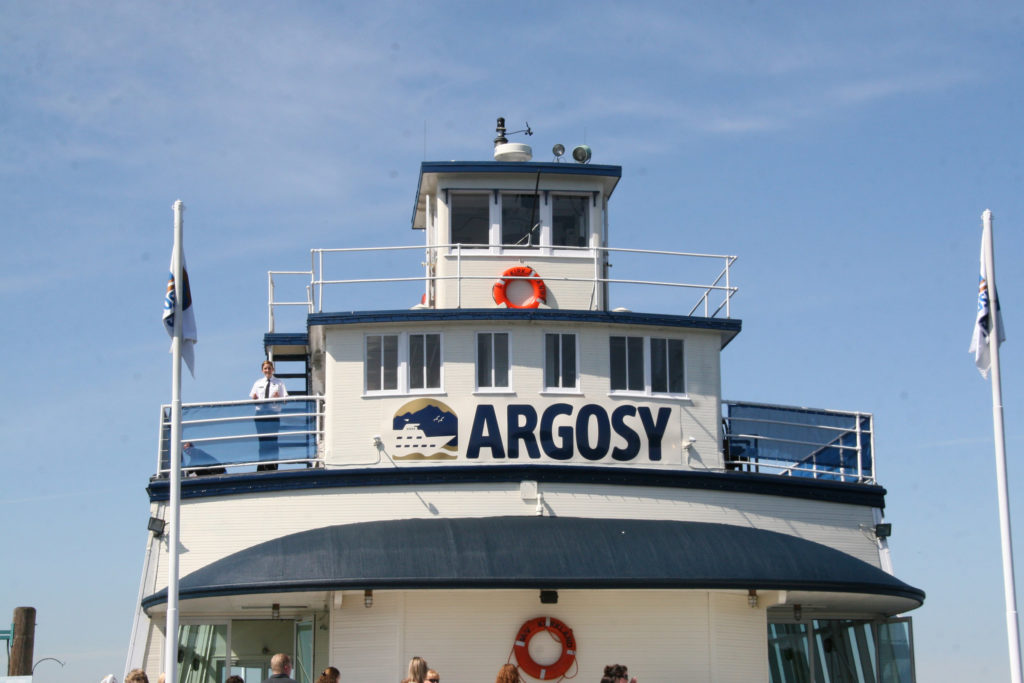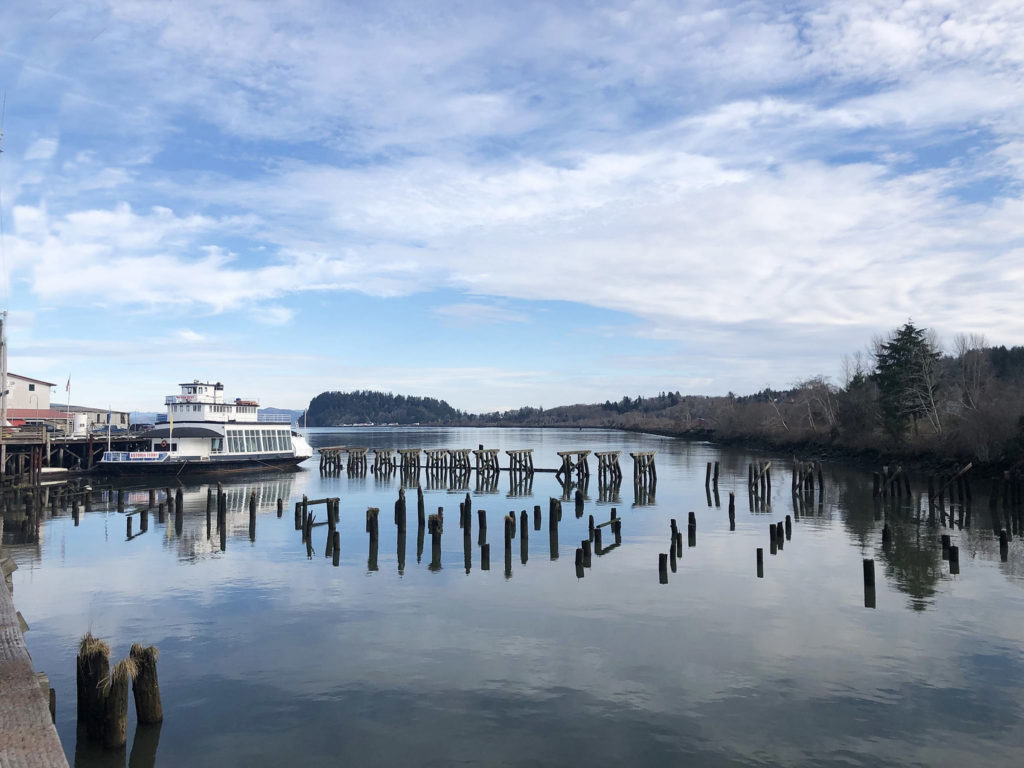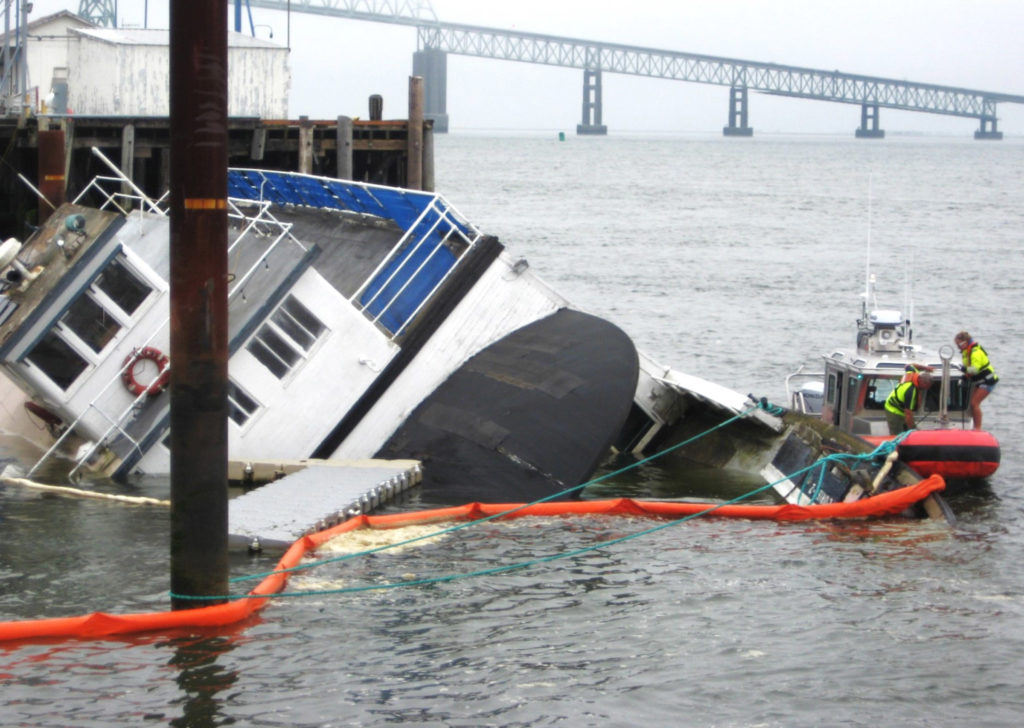
For visitors to Seattle or residents who’ve never seen the city from the water, a trip on a tour boat is the quickest and easiest way to appreciate the beauty of the shoreline and the important part traditional ferry boats played in its growth. In the late 1800s, before all the bridges and roads were built, there were so many small ferries buzzing back and forth on Puget Sound that they were known as the “mosquito fleet.”
Only a handful of these historic vessels are still afloat, and unfortunately, one of them, the former Astoria car ferry Tourist No.2 launched in 1924, came to an ill-fated end this past summer when she sank on the Astoria waterfront.
It was an inglorious farewell, after a decade long effort to save her, but Tourist No.2 left behind a fascinating life story that was in many ways stranger than fiction—and well worth retelling. In simple numbers, the grand old dame served 40 years on the Columbia River, followed by 50 years on Puget Sound, before making one final trip back to her birthplace in Astoria in a vain attempt to find a safe “retirement home.”
This was where the Tourist No.2had been stoutly built by the Evans yard in 1924 with a flat-bottomed hull so it could carry 22 cars to Washington and back across the shallows and sandbanks of the river. The ferry soldiered on through the war years working for the U.S. Army guarding the river’s entrance. It went back to civilian life in 1946 and put in another 20 years of routine ferry work. This route was based on the Oregon side, so was not affected when the Washington State Department of Transportation bought all the major ferry lines in the state in 1951 and formed the state ferry system. (WSDOT passed the responsibility for the five shortest routes to the counties, including the shortest route of all, 30 miles upstream from Astoria connecting Puget Island, Washington, with Westport, Oregon.)
Tourist No.2chugged along for another 20 yearsuntil the post-war transport boom finally reached the coast and the four-mile-long bridge over the Columbia was opened, closing the last gap in the coastal Highway 101. That was the end of the local ferry line and its three tugs went their different ways. The newest steel boat ended up in Vietnam, and the Tourist No.2also got another chance. It had been well maintained, so Pierce County in Washington state decided to give it another chance running the Steilacoom to Anderson Island route, where it would be a definite improvement over the wooden ferry built in 1916 with a capacity of just nine cars.
Re-named the Islander, with the upper deck raised to allow tall trucks on board,it served on the South Sound for an incredible 30 years without incident. The county finally got a new 200’ steel ferry in 1997. It was named the Christine Anderson and coincidentally was also built in Oregon—at Nichols Brothers’ short-lived yard in St. Johns, Portland. (I saw and wrote about that at the time, but it is only now that I have learned it replaced the old Astoria ferry.) This time it really looked like the end of the line for the old wooden boat, now nearing 75 years old.
The only use for the hull was probably moving construction equipment or gravel around the islands. But yet again the ferry was thrown a lifeline by Kevin Clark, then CEO of Argosy Cruises, which was based in Kirkland at that time, but now works out of Pier 55 and 54 on the Seattle downtown waterfront. He saw real potential in the boat and bought it for $50,000. Then, Argosy spent a year to clean, repair, and convert it into a sightseeing vessel, adding two full service bars, a galley, and 12-foot floor-to-ceiling windows following a design provided by Seattle’s own Jonathan Quinn Barnett, who in the ensuing years moved up into the exclusive world of superyacht design.
It cost well over $500,000 to re-launch the re-named M.V. Kirkland and this effort was rewarded by the boat being added to the Washington Heritage Register and National Register of Historic Places. Its new career took it around Lake Washington and occasionally into Lake Union, hosting private parties, weddings, and special events for the next 15 years. For the third time in its long life, the boat became a local favorite to everyone who saw it brightening up the scene, especially at night when it was lit up during Argosy’s Christmas Ship™ Festival. Indeed, there must be a few of our readers who recall a trip on the M.V. Kirkland when it was “Seattle’s favorite party boat.”
Throughout its career in the Seattle area, the Kirkland Reporter kept track of the boat it called “an icon on their waterfront.” That publication’s last story on the vessel in 2008 recalled that she made a cameo appearance on ABC’s “The Bachelor,” was featured in a centerfold shot within 425 magazine, and was already popular on social media. To the Argosy employees and many residents of Kirkland, the boat felt like a community member. Luckily for us, the Reporter consistently reported on the boat, especially when the original wooden hull had to be dry-docked every two years for the Coast Guard safety inspection for passenger vessels.
This usually required the replacement of a few rotten planks and frames with clear-grain, old-growth Douglas fir. Argosy kept a stockpile of this lumber for future use, but the haul out and skilled labor cost $70,000 to $100,000 because most local shipyards had quit working on traditional wooden boats. Steel is not only more durable and relatively easy to repair, it is also fire-resistant, and it was an electrical fire in the engine room early on August 28, 2010, that finally brought the Kirkland to another change of course.
More than 50 firefighters responded quickly to the pier and the fire was almost out within 30 minutes. Most of the damage was below deck and out of sight, but there was smoke damage throughout the boat. Predictably, the end result was the historic vessel being declared a total loss. Three days later, it was towed from Lake Washington by the 51’ Dixie to the Ship Canal where it was put up for sale. (That tug also has a long history: launched in 1951 for work at Kettle Falls behind the Grand Coulee Dam, then heading to the coast. Over the last 20 years, Fremont Tug has invested a lot of effort in rebuilding and updating it to continue working inside the Ballard Locks.)
Argosy had to move on and began building a fleet of modern steel cruising boats, but still had regrets about selling the Kirkland. “The boat has been a labor of love for this company and a source of pride for us and the community,” said Clark. “I am open to any opportunities to see it find another mission. It would pain me to see it sent to a salvage company for disposal,” he admitted. “We are continuing to leave no stone unturned.” (My recommendation would have been to haul it on shore and turn it into a restaurant or salesroom, but that would have involved finding a suitable site, organizing haulage from a slipway, gaining planning permission etc. all of which would require vision and deep pockets.)
Unfortunately, that is not the way the world of historic ship preservation works, and turning the boat into an office would have been anathema to a real antique boat enthusiast like Christian Lint, who became the boat’s last owner in 2010. He already had experience with old boats picked up at bargain prices and he quickly demonstrated his talent for by repairing the electric circuits sufficiently to get the Kirkland’s engine running and moving it to Bremerton. Over the next few years, he tried renting it out at the dockside for private events, which did not require the same level of Coast Guard licensing.

His long-term plan was to act as caretaker and sell it to anyone who recognized its historical value—a rather vague financial concept. By 2016, having reportedly resisted offers to turn the “Tourist No.2 into a floating casino, strip club, or cannabis bar,” Lint determined that the aging ferry’s best hope was a risky move down the coast back to Astoria to join in the 50th birthday celebration of the bridge in 2016. He hoped a group of local fans would develop a non-profit organization to buy the boat and preserve it.
The boat was moored at the east end of town and became the center of attention. A team of volunteers began cleaning up the boat, patching the roofing, and holding fundraising events. The ferry group raised more than $160,000, which may have been enough to buy the boat, but left nothing for the restoration—estimated at anywhere from $500,000, according to Lint, to as high as $3 million by an expert in preservation. I interviewed Lint while writing a story for a local publication and found him to be a fascinating character who could tell exciting sea stories—especially to anyone who showed interest in his boats.
However, I had also learned from experience that the expression “a hole in the water you throw money into” was coined to warn sailors about the perils of owning old wooden boats like this. The ferry truly fit the bill—it needed a steady stream of labor and money to stay afloat, and I declined the invitation to join the Astoria Ferry Group. As the months slipped by, the immensity of the task eventually wore the ferry fans out, leaving Lint and the boat back at square one. He listed the boat on Craigslist for $225,000—presumably his idea of the “historical value”—and checked along Astoria’s three-mile waterfront searching for a spot where he could moor without charge. (This was a skill I imagine he had perfected over the years.)
He found an empty submerged lot on the downtown waterfront at the end of Sixth Street where a dozen steel pilings had been driven for a condo project that had also ran out of funds. This was where the Tourist No. 2 spent its last two years, with a “for sale” sign inside one of the tall car-deck windows. This was illegal of course, but Lint knew that none of the people and agencies with some responsibility for it would be in a rush to start eviction proceedings. I passed the boat at least once a week while biking along the Riverwalk, and like everyone else, I assumed that Lint or one of his crew was checking the pumps regularly.
Or not. All seemed well until this past summer, when a leak must have opened up in the heavy planking below the waterline. It appeared as if the small wind turbine and solar panel on the roof were unable to keep up with the load from the pump. Within hours on that fateful day of July 27, the Tourist No. 2 had heeled onto its side, with water lapping across the car deck until the chine (corner) of the hull touched the bottom. Soon, a workboat and a crane barge were alongside with the crews assessing the situation. Fuel oil was leaking out and spreading along the shore, so a boom was laid around the wreck and attempts were made to close off the fuel tank vents. For the next week, the ferry slowly slid further below the water until only the top of the funnel was visible at high tide.
Who has jurisdiction over derelicts is a continuing issue all over the West Coast, but because of the immediate emergency, Oregon’s Department of State Lands had taken the lead and found funds to pay for the clean-up. On August 4, the salvage contractor attempted to refloat the hull with a crane barge, but divers found it was too far gone to withstand the strain of a being hoisted in one piece. It was now self-evident that the boat’s luck had finally run out, although there were still some local fans insisting it be should be given one more chance. (Lint was conspicuously absent.)
Bruce Jones, the Mayor of Astoria and former commander of US Coast Guard Sector Columbia, began putting out reports on the situation online. On August 6 he wrote: “Yesterday divers pumped 125 gallons of diesel from the fuel tank, emptying it, and removed 5 cubic yards of fuel-soaked absorbent material, 3×5 gallon containers of motor oil, propane tanks, paint, other assorted hazardous waste and fuel-soaked life jackets and other materials.”
By August 10, the subcontractor Advanced American Construction arrived with a barge loaded with enough pontoons to completely encircle the wreck. Then the crane barge went to work with its heavy claw and the once proud little ship was quickly reduced to a pile of crushed lumber on the cargo barge’s deck. After almost a century on the waters of the Pacific Northwest, the remarkable life of the wooden car ferry Tourist No. 2 came to an abrupt and very public halt. Ironically this all happened just eight blocks from the ferry’s original berth at the old ferry dock on 14th St. where it had plied its trade across the Columbia back in 1924. “This was a sad ending to a historic vessel, but unfortunately, her fate was sealed many years ago when the extensive, expensive hull maintenance that old wooden boats require was not performed regularly,” explained Mayor Jones in his final report.
This should have brought this sorry saga to an end, but the plot took another unexpected and truly tragic turn in Portland on August 30. It appears that while his ferry was being demolished, Christian Lint was avoiding the spotlight and continuing to live on another of his craft at a moorage on Marine Drive near the Portland Expo Center. During an altercation with prowlers who targeted his pickup truck, Lint was struck by a semi-truck and killed.
As for Tourist No.2, its final destination was the regional landfill in Arlington, Oregon, a hamlet 225 miles away on the east side of the Columbia Gorge that also takes the garbage from cities like Seattle and Portland. Though it was not the end anyone would have imagined or wanted, this boat will continue to be remembered by the many people who rode on it, admired it at the dock, or watched it gallantly plying its way across waterways of the Northwest. We all bid it a fond adieu.
